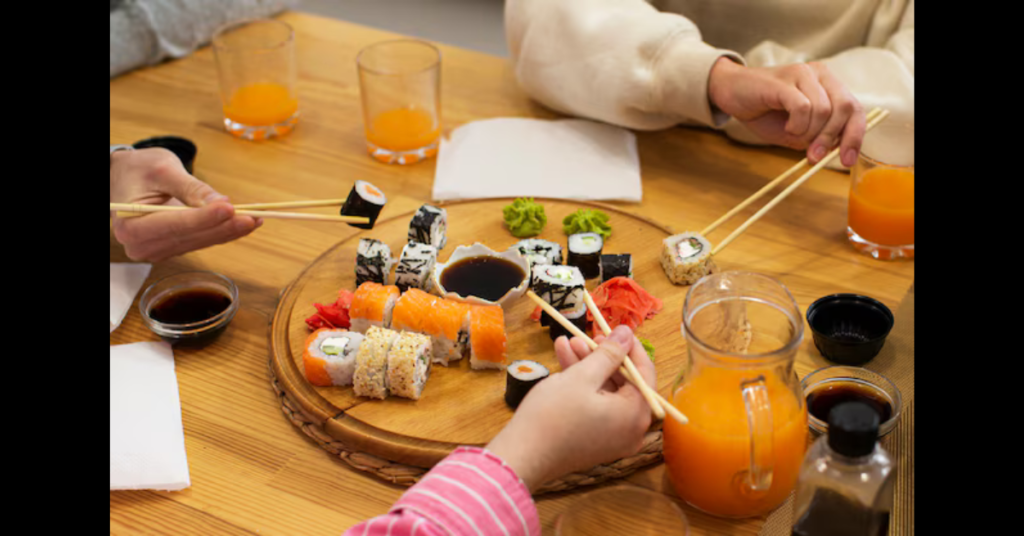Kani sushi, also known as crab sushi, is a delightful and popular dish in Japanese cuisine. With its rich flavors, delicate textures, and artistic presentation, kani sushi has captivated the palates of many sushi enthusiasts worldwide. This comprehensive guide will explore the origins of kani sushi, its various forms, ingredients, preparation methods, nutritional aspects, and tips for enjoying this delicious seafood delicacy.
1. Understanding Kani Sushi
1.1 Definition of Kani
The term “kani” (蟹) translates to “crab” in Japanese. In sushi, kani typically refers to either real crab meat or imitation crab meat, known as “surimi.” While traditional sushi may feature fresh, cooked crab meat, many sushi restaurants often use imitation crab due to its affordability, convenience, and consistent flavor.
1.2 Types of Kani Sushi
Kani sushi comes in various forms, each with unique preparation methods and presentations. Some popular types of kani sushi include:
- Kani Nigiri: A simple yet elegant presentation of crab meat atop a small mound of vinegared rice, usually garnished with wasabi and a slice of nori (seaweed).
- Kani Maki: A sushi roll that includes crab meat, rice, and various fillings, all wrapped in nori and sliced into bite-sized pieces. Kani maki can feature additional ingredients such as cucumber, avocado, or cream cheese.
- Kani Sashimi: Slices of fresh crab meat served without rice, often accompanied by soy sauce and garnishes.
- Kani Temaki: A hand-rolled sushi cone filled with crab meat, rice, and various vegetables, wrapped in a sheet of nori.
2. Origins of Kani Sushi
The origins of sushi date back to ancient Japan, where it was developed as a method of preserving fish in fermented rice. Over time, sushi evolved into the diverse and refined cuisine we know today. Kani sushi, specifically, reflects the broader trends in Japanese culinary culture, where the focus on fresh, high-quality ingredients and artistic presentation plays a vital role.
2.1 The Role of Crab in Japanese Cuisine
Crab has long been a prized ingredient in Japanese cuisine, celebrated for its delicate flavor and versatility. Different regions in Japan offer unique crab dishes, such as:
- Kanazawa: Known for its snow crab (zuwai-gani), which is harvested from the Sea of Japan during the winter months.
- Hokkaido: Famous for its king crab (tarabagani) and hairy crab (wakarigani), both of which are sought after for their rich, sweet meat.
The inclusion of crab in sushi reflects the Japanese emphasis on using local, seasonal ingredients, making kani sushi a natural and popular choice among sushi lovers.
3. Ingredients in Kani Sushi
3.1 Types of Crab
The primary ingredient in kani sushi is, of course, crab. Depending on the type of kani sushi being prepared, the following varieties may be used:
- Real Crab: Freshly cooked crab, such as Dungeness crab, king crab, or snow crab, offers the best flavor and texture. This option is often preferred for high-end sushi restaurants.
- Imitation Crab (Surimi): A popular and cost-effective alternative to real crab, imitation crab is made from fish, typically Alaskan pollock, that has been processed and flavored to resemble crab meat. While it lacks the richness of real crab, it is widely used in sushi rolls and casual dining settings.
3.2 Sushi Rice
Sushi rice, or shari, is an essential component of any sushi dish, including kani sushi. The rice is typically seasoned with a mixture of rice vinegar, sugar, and salt to create a slightly tangy and flavorful base that complements the crab.
3.3 Nori
Nori, or seaweed, is commonly used in sushi preparations, especially in maki and temaki. It adds a unique flavor and texture, while also providing a beautiful presentation.
3.4 Other Ingredients
Depending on the type of kani sushi, various additional ingredients may be used, including:
- Vegetables: Common additions include cucumber, avocado, and radish, which provide freshness and crunch.
- Sauces: Soy sauce, wasabi, and ponzu sauce are popular accompaniments for enhancing flavor.
- Garnishes: Ingredients like sesame seeds, scallions, or fish roe can be used to elevate the presentation.
4. Preparation Methods
The preparation of kani sushi involves several key steps, from selecting high-quality ingredients to assembling the final dish. Below are detailed instructions for preparing different types of kani sushi.
4.1 Kani Nigiri
Ingredients
- Fresh crab meat (or imitation crab)
- Sushi rice
- Wasabi (optional)
- Nori (optional)
Instructions
- Prepare the Sushi Rice: Rinse 2 cups of sushi rice under cold water until the water runs clear. Cook the rice according to your rice cooker or package instructions. Once cooked, transfer the rice to a large bowl and gently fold in a mixture of rice vinegar, sugar, and salt while it cools.
- Shape the Nigiri: Wet your hands to prevent sticking, and take a small amount of sushi rice (about 1-2 tablespoons). Shape it into an oval mound.
- Add the Crab: Place a small piece of crab meat on top of the rice mound. If desired, add a dab of wasabi between the rice and crab.
- Serve: Arrange the kani nigiri on a plate and serve with soy sauce for dipping.
4.2 Kani Maki
Ingredients
- Sushi rice
- Fresh crab meat (or imitation crab)
- Nori
- Fillings (cucumber, avocado, or others)
- Soy sauce (for serving)
Instructions
- Prepare the Sushi Rice: Follow the same method as above to prepare sushi rice.
- Prepare the Nori: Cut a sheet of nori in half and place it shiny side down on a bamboo sushi mat.
- Spread the Rice: Wet your hands and take a handful of sushi rice, spreading it evenly over the nori, leaving a small border at the top.
- Add Fillings: Place crab meat and any additional fillings in a line across the center of the rice.
- Roll the Sushi: Using the sushi mat, roll the nori tightly from the bottom to the top, applying gentle pressure to create a firm roll. Seal the edge with a little water.
- Slice and Serve: Using a sharp knife, slice the roll into bite-sized pieces. Serve with soy sauce.
4.3 Kani Sashimi
Ingredients
- Fresh crab meat
- Soy sauce (for dipping)
- Wasabi (optional)
- Lemon wedges (for garnish)
Instructions
- Prepare the Crab: If using fresh crab, cook and shell it, ensuring you have clean, intact pieces of crab meat.
- Slice the Crab: Using a sharp knife, slice the crab meat into thin pieces, arranging them neatly on a plate.
- Serve: Garnish with lemon wedges and serve with soy sauce and wasabi.
4.4 Kani Temaki
Ingredients
- Sushi rice
- Fresh crab meat (or imitation crab)
- Nori
- Fillings (cucumber, avocado, or others)
- Soy sauce (for serving)
Instructions
- Prepare the Sushi Rice: Follow the same method as above to prepare sushi rice.
- Prepare the Nori: Cut a sheet of nori into quarters.
- Fill the Nori: Place a small amount of sushi rice on one corner of the nori and top it with crab meat and desired fillings.
- Roll the Sushi: Starting from the corner with the rice, roll the nori into a cone shape, enclosing the fillings.
- Serve: Serve immediately with soy sauce.
5. Nutritional Aspects of Kani Sushi
Kani sushi can be a delicious and nutritious addition to a balanced diet, depending on the ingredients used. Here’s a breakdown of the nutritional aspects:
5.1 Health Benefits of Crab
Crab is a good source of protein, omega-3 fatty acids, vitamins, and minerals. Some key nutritional benefits include:
- High Protein Content: Crab meat is rich in protein, essential for muscle building and overall health.
- Omega-3 Fatty Acids: These healthy fats support heart health, reduce inflammation, and promote brain function.
- Low in Calories: Crab is relatively low in calories compared to other protein sources, making it a suitable option for weight management.
- Rich in Vitamins and Minerals: Crab provides essential nutrients, including vitamin B12, zinc, and selenium.
5.2 Nutritional Comparison: Real Crab vs. Imitation Crab
While imitation crab is a popular and cost-effective alternative, it differs significantly in nutritional content compared to real crab:
- Protein: Real crab contains higher protein levels, while imitation crab is often lower in protein.
- Fat Content: Imitation crab typically contains more carbohydrates and less healthy fat than real crab.
- Sodium: Imitation crab may contain added sodium and preservatives, making it less suitable for individuals monitoring their sodium intake.
5.3 Sushi Rice and Other Ingredients
Sushi rice, while providing a base for kani sushi, contributes carbohydrates and calories. Depending on the type of fillings and sauces used, the overall nutritional profile of kani sushi can vary significantly. For example, avocado and cucumber add healthy fats and fiber, while sauces like soy sauce may increase sodium levels.
6. Tips for Enjoying Kani Sushi
To fully appreciate kani sushi, consider the following tips:
6.1 Choosing the Right Restaurant
When seeking out kani sushi, look for reputable sushi restaurants that prioritize fresh, high-quality ingredients. Ask about their sourcing practices for crab and other seafood.
6.2 Pairing with Beverages
Kani sushi pairs well with a variety of beverages, including:
- Sake: The traditional Japanese rice wine enhances the flavors of sushi.
- Green Tea: A refreshing accompaniment that complements the delicate flavors of crab.
- Beer: Light, crisp beers can balance the richness of kani sushi.
6.3 Experimenting with Flavors
Feel free to customize kani sushi with different fillings, sauces, and garnishes. Try adding spicy mayo, eel sauce, or sesame seeds to enhance the flavor profile.
6.4 Mindful Eating
Savor each bite of kani sushi, focusing on the flavors and textures. Enjoy the experience of sushi dining by practicing mindful eating, which can enhance your overall enjoyment of the meal.
7. Conclusion
Kani sushi is a delicious and versatile dish that showcases the rich flavors of crab while reflecting the artistry of Japanese cuisine. With its various forms, preparation methods, and nutritional benefits, kani sushi is a beloved choice for sushi enthusiasts and newcomers alike. By understanding its origins, ingredients, and preparation techniques, you can appreciate the unique qualities of kani sushi and enjoy its delightful taste. Whether you prefer kani nigiri, kani maki, or kani temaki, this seafood delicacy is sure to satisfy your cravings and provide a memorable dining experience.
4o mini







